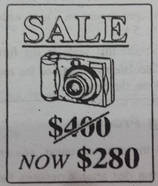This section requires Javascript.
You are seeing this because something didn't load right. We suggest you, (a) try
refreshing the page, (b) enabling javascript if it is disabled on your browser and,
finally, (c)
loading the
non-javascript version of this page
. We're sorry about the hassle.
10 solutions
This one's simple:
$280 (the price of the camera now) $400 (the original price of the camera)
$400-$280=$120
$120/$400=0.30 or 30%
Discounted amount = 400-280 = 120
Per cent means "per hundred".
That's 30 dollars off "per hundred" dollars of the original price(4 * $100), or 30% off.
The camera has been discounted to $280 from $400.
Hence discount of 120 on 400.
Converting into percentage it works out to be 120/400=.30 or 30%.
Moderator note:
Good solution. It is important to know that the denominator should be the "initial value", instead of the "final value".
Percentage reduced={ (400 - 280)/ 400 } × 100 => 30 %
Nice answer !!
280/400 =70% So discount= 100-70 = 30%
Discount%= (400 - 280)x100/400 = 120/4 = 30 %
P - D = F, where P is the original price; D (discount) = Pd, where d is the discount rate; F is the final price.
400 - 400d = 280 d = 0.3; therefore, discount rate is 30%.
$ 4 0 0 $ 4 $ 2 0 $ 4 0 0 − $ 2 8 0 = $ 1 2 0 = 1 0 0 % = 1 % = 5 % = 3 0 %

$400 x 0.30 = 120...Then $120 + $280 = $400, then the should be 0.30 = 30%